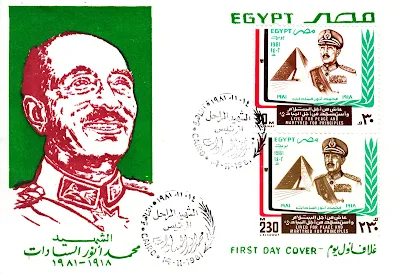EGYPT in 1981 issued two first day cover stamps honouring the late Egyptian President Anwar el-Sadat. The set entitled "Lived for Peace and Martyred for Principles" depicted an illustration of Sadat and the Great Pyramid of Giza with a Cairo cancellation.
Muhammad Anwar el-Sadat (1918 -1981) was an Egyptian politician who served as the third president of Egypt, from 15 October 1970 until his assassination by fundamentalist army officers on 6 October 1981. Sadat was a senior member of the Free Officers who overthrew King Farouk in the Egyptian Revolution of 1952, and a close confidant of President Gamal Abdel Nasser, under whom he served as Vice President twice and whom he succeeded as president in 1970. In 1978, Sadat and Menachem Begin, Prime Minister of Israel, signed a peace treaty in cooperation with United States President Jimmy Carter, for which they were recognized with the Nobel Peace Prize.
In his eleven years as president, he changed Egypt's trajectory, departing from many of the political and economic tenets of Nasserism, re-instituting a multi-party system, and launching the Infitah economic policy. As President, he led Egypt in the Yom Kippur War of 1973 to regain Egypt's Sinai Peninsula, which Israel had occupied since the Six-Day War of 1967, making him a hero in Egypt and, for a time, the wider Arab World. Afterwards, he engaged in negotiations with Israel, culminating in the Egypt–Israel Peace Treaty; this won him and Menachem Begin the Nobel Peace Prize, making Sadat the first Muslim Nobel laureate.The peace treaty was also one of the primary factors that led to his assassination; on 6 October 1981, militants led by Khalid Islambouli opened fire on Sadat with automatic rifles during the 6 October parade in Cairo, killing him.
Sadat’s death set in train the disastrous road to the war in Lebanon in 1982, the creation of Hezbollah, and the seeds of al-Qaida.
Ariel Sharon embarked on the disastrous June 1982 invasion that led to the Sabra and Shatila Palestinian refugee camps massacre in September, the April 1983 suicide bombing of the U.S. Embassy that killed 63 people including seven CIA officers, and the October 1983 bombing of the Marine barracks at Beirut airport that killed 241 Marines, sailors, and soldiers. The invasion also led to the creation by Iran of Hezbollah, which ultimately drove the Israelis out of even the most southern part of Lebanon in 2000. President Ronald Reagan withdrew the Marines after the bombing of the Marine barracks and Syria and Iran were triumphant.
On the fringe of the assassination plot in 1981 was a prominent Egyptian doctor named Ayman al-Zawahiri who was arrested in the police sweeps after Sadat’s murder. Because of his language skills and demeanor, Zawahiri became the spokesperson for the plotters in prison. Released for lack of evidence, Zawahiri has been on the run ever since.As Osama bin Laden’s deputy and eventual successor, Zawahiri has been the leading ideologue of al-Qaida since its birth. He articulated its goal as being to destroy America’s will to support Israel.
In his eleven years as president, he changed Egypt's trajectory, departing from many of the political and economic tenets of Nasserism, re-instituting a multi-party system, and launching the Infitah economic policy. As President, he led Egypt in the Yom Kippur War of 1973 to regain Egypt's Sinai Peninsula, which Israel had occupied since the Six-Day War of 1967, making him a hero in Egypt and, for a time, the wider Arab World. Afterwards, he engaged in negotiations with Israel, culminating in the Egypt–Israel Peace Treaty; this won him and Menachem Begin the Nobel Peace Prize, making Sadat the first Muslim Nobel laureate.The peace treaty was also one of the primary factors that led to his assassination; on 6 October 1981, militants led by Khalid Islambouli opened fire on Sadat with automatic rifles during the 6 October parade in Cairo, killing him.
Sadat’s death set in train the disastrous road to the war in Lebanon in 1982, the creation of Hezbollah, and the seeds of al-Qaida.
Ariel Sharon embarked on the disastrous June 1982 invasion that led to the Sabra and Shatila Palestinian refugee camps massacre in September, the April 1983 suicide bombing of the U.S. Embassy that killed 63 people including seven CIA officers, and the October 1983 bombing of the Marine barracks at Beirut airport that killed 241 Marines, sailors, and soldiers. The invasion also led to the creation by Iran of Hezbollah, which ultimately drove the Israelis out of even the most southern part of Lebanon in 2000. President Ronald Reagan withdrew the Marines after the bombing of the Marine barracks and Syria and Iran were triumphant.
On the fringe of the assassination plot in 1981 was a prominent Egyptian doctor named Ayman al-Zawahiri who was arrested in the police sweeps after Sadat’s murder. Because of his language skills and demeanor, Zawahiri became the spokesperson for the plotters in prison. Released for lack of evidence, Zawahiri has been on the run ever since.As Osama bin Laden’s deputy and eventual successor, Zawahiri has been the leading ideologue of al-Qaida since its birth. He articulated its goal as being to destroy America’s will to support Israel.
Source: Wikipedia and Brookings Institute

No comments:
Post a Comment